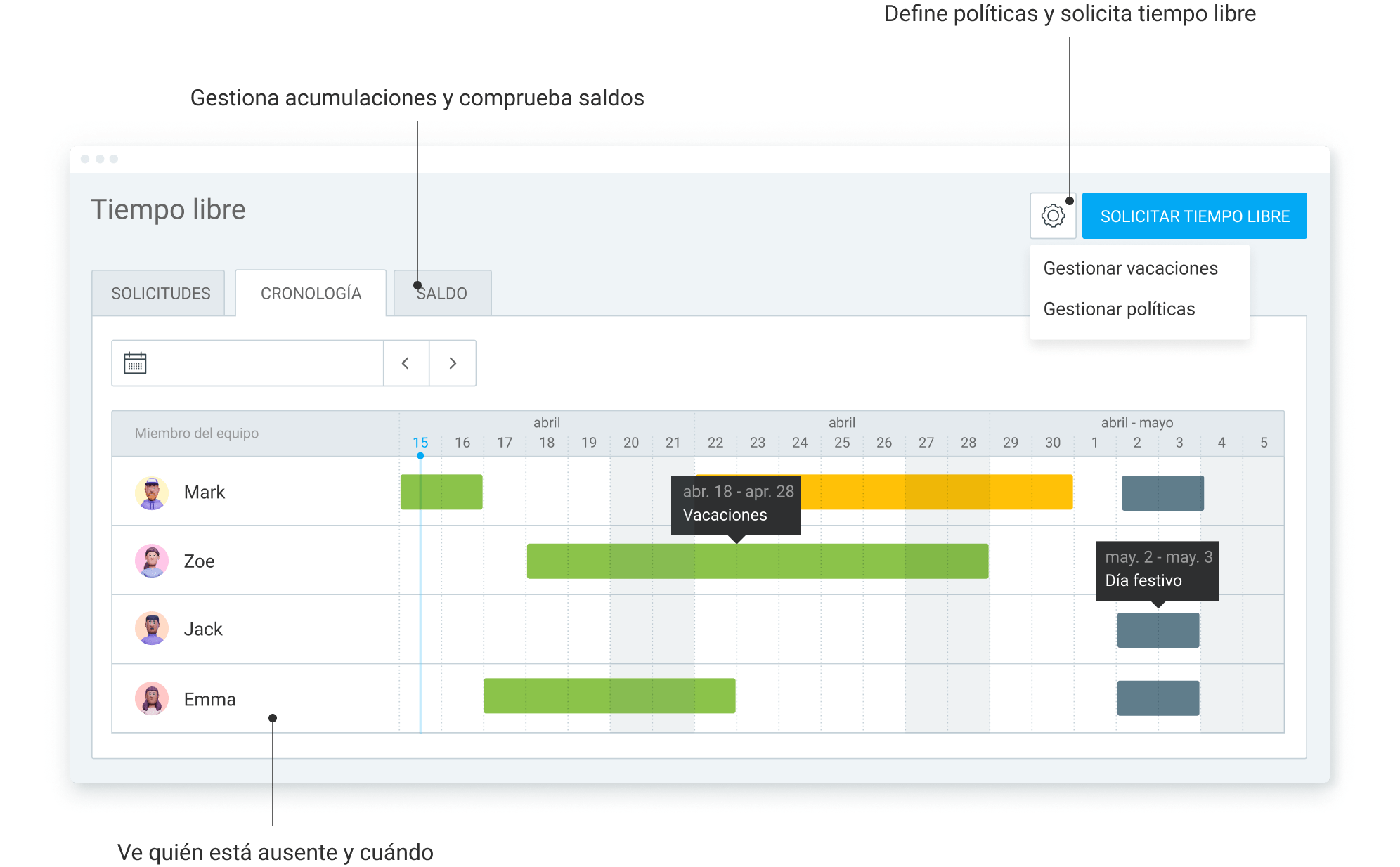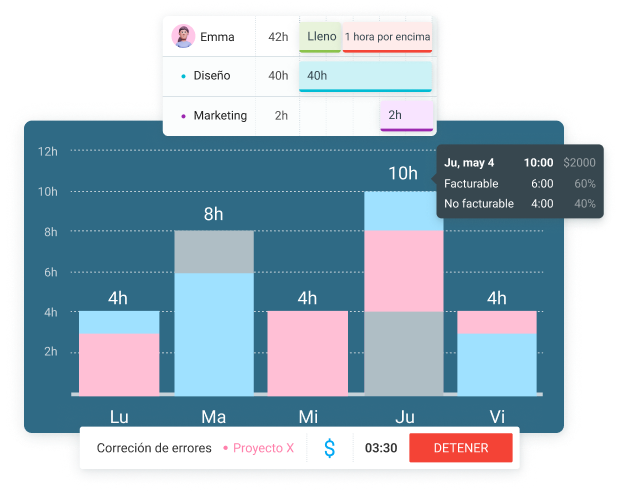Aceptar una oferta de trabajo significa un entendimiento mutuo entre un empleador y un empleado. Dictado por una oferta escrita y a menudo verbal, el empleado se compromete a desempeñar su trabajo al más alto nivel mientras que el empleador lo compensa con un salario, condiciones de trabajo adecuadas y beneficios. Uno de esos beneficios es el tiempo libre (personal) remunerado — el PTO.
Aunque no es obligatorio por la ley federal, muchos estados estadounidenses y los empleadores ofrecen a sus respectivos empleados el tiempo libre remunerado, lo que mantiene a todos satisfechos, motivados y dispuestos a contribuir en cualquier momento.
Sin embargo, los empleadores deben entender todos los matices detrás de la acumulación del PTO y cómo funciona para garantizar el mejor resultado posible para ambas partes.
Para hacer que las cosas sean aún más fáciles y comprensibles, hemos preparado una guía detallada para ayudar a los empleados y empleadores a llegar al fondo del PTO.
En esta guía, aprenderás más sobre:
- El PTO y el PTO acumulado,
- Los beneficios del tiempo libre acumulado,
- Establecer las políticas de acumulación del PTO, y
- Calcular el PTO.

- Las 2 políticas más populares del tiempo libre son el PTO acumulado y la suma global.
- El PTO acumulado permite que los empleados ganen los días de vacaciones, de enfermedad y personales en vez de recibir una cantidad fija al principio de cada año calendario.
- Cuando diseña una baja de PTO, un empleador debería considerar las tarifas de acumulación, el período y el límite.
- Si el PTO no se utiliza completamente durante un año calendario, los empleadores pueden optar por ‘transferir’ los días remunerados restantes o pagarlos a través de los salarios por hora de sus empleados.
¿Qué es PTO acumulado?
El PTO acumulado representa una acumulación de tiempo libre personal durante un período de tiempo.
El tiempo libre remunerado es generalmente presentado a través de las políticas establecidas por el empleador que permiten que los empleados ganen tiempo libre remunerado trabajando cierta cantidad del tiempo. Sin embargo, qué es el PTO y cómo funciona no está definido claramente por la ley de los Estados Unidos.
En la mayoría de los casos, las políticas de PTO combinan los tres tipos de permiso:
- Días de vacaciones,
- Días por enfermedad, y
- Días personales.
Hemos contactado a Levon L. Galstyan, Contable público certificado en Oak View Law Group, para obtener ayuda con la definición de PTO acumulado:

“El PTO acumulado es un método usado por los empleados para seguir y gestionar la cantidad de tiempo libre pagado que un empleado haya ganado y haya tomado durante un período de tiempo específico. Las políticas de PTO acumulado varían entre empresas, pero el principio básico es que los empleados ganan una cierta cantidad de PTO por cada hora, día, o periodo pagado trabajado.”
Aunque las leyes de EE.UU no requieren que los empleadores tengan políticas de PTO vigentes, algunos estados tienen sus propias regulaciones de tiempo libre. Sin embargo, ninguna de las leyes estatales exige que los empleadores hagan cumplir PTO acumulado, dado que el tipo de política de tiempo libre depende completamente de ellos.
Adicionalmente, la Ley Federal de Licencia Familiar y Médica (FMLA, por sus siglas en inglés) destaca claramente que ningún empleador está obligado a ofrecer el tiempo libre remunerado por razones de calificación, como la emergencia familiar, recuperar de una enfermedad o cuidar a un ser querido.
Sin embargo, es importante notar que el empleador está libre de ofrecer la FMLA remunerada e instalar las políticas de la FMLA remunerada si eligen hacerlo. En estos casos, el empleador regula las condiciones y el método de acumulación según lo considere oportuno.
PTO acumulado vs. PTO de suma global
En general, los empleadores a menudo eligen entre una de las dos políticas más populares:
- PTO acumulado, y
- PTO asignado (suma global).
La suma global de PTO es una política de tiempo libre pagado en la que los trabajadores tienen una cantidad establecida de tiempo libre pagado durante un año. Esta política puede caducar o trasladarse al siguiente año. Además, algunas empresas pagan a los trabajadores el tiempo libre asignado no utilizado durante el año.
Fundadora y Contable público en The Alajian Group, Armine Alajian explica que la diferencia entre estos dos términos está en la forma en que se calculan:

“La diferencia principal entre el PTO acumulado y suma global de PTO es cómo tu empleador calcula la cantidad de tiempo libre pagado que recibes. En el caso de PTO acumulado, tu PTO se basa en el número de horas que trabajas, mientras que en el caso de la suma global de PTO, todos reciben la misma cantidad fija de PTO, independientemente de cuántas horas hayan trabajado.”
La información que proporcionó Levon L. Galstyan nos ayudó crear una tabla con las diferencias principales entre políticas de PTO acumulado y PTO asignado:
| Diferencias | PTO acumulado | Suma global de PTO asignado |
|---|---|---|
| Momento de pago | Los empleados ganan PTO con el tiempo. | Los empleados reciben todo su PTO de una vez. |
| Valor en efectivo | Un valor en efectivo equivale a una tarifa por hora del empleado o a un salario multiplicado con el número de horas acumuladas. | Un valor en efectivo equivale a una tarifa por hora o a un salario multiplicado con el número de horas de PTO no usadas. |
| Responsabilidad de empleador | Los empleadores deben seguir el PTO acumulado de los empleados y asegurarse de brindarles el tiempo libre al que tienen derecho, lo que puede crear desafíos logísticos. | Los empleadores deben tener recursos financieros para cubrir el uso de PTO de los empleados en suma global cuando un empleado lo solicita, lo que puede crear desafíos financieros. |
Nota: Los datos en esta tabla no son datos oficiales. La FLSA no contiene ninguna obligación hacia los empleadores con respecto al PTO y el tipo de política del PTO que pueden crear para sus empleados.
Beneficios de tiempo libre acumulado
Los empleadores prefieren las políticas de baja de tiempo libre acumulado por varias razones. Estas políticas benefician a ambas partes de diferentes maneras, algunas de las cuales discutiremos a continuación.
¡Atentos a lo que viene!
Beneficio 1: PTO acumulado fomenta la retención de empleados
El PTO acumulado permite que organices una política de permiso pagado como quieras en tu empresa. Si quieres fomentar la retención del empleado, deberías crear una política que:
- Está basada en los años de servicio, o
- Permite transferir tiempo libre no usado a lo largo de los años.
Deberías considerar añadir tarifas más altas de PTO para personas que han sido parte del equipo por más tiempo. De esa manera, tus trabajadores están más motivados de quedar dentro de la empresa y recoger más días durante el tiempo.
🎓 La guía más completa sobre la compensación laboral
Beneficio 2: PTO acumulado previene que los empleados tomen demasiado tiempo libre
Con la forma en que el PTO funciona, tus empleados no podrán recibir su PTO de repente. Por lo tanto, no tendrán demasiados días libres a su disposición cuando comiencen a trabajar para tu empresa.
Este tipo de política previene que nuevos empleados tomen demasiado tiempo libre en el comienzo ya que su PTO se acumulará cuando continúan trabajando.
Controla la acumulación de PTO con Clockify
Beneficio 3: PTO acumulado proporciona una recompensa para trabajadores leales
El PTO acumulado se cobra a lo largo del tiempo. Por lo tanto, tus trabajadores más leales deberían tener más tiempo libre pagado durante el año.
Si eliges tener una política que permite una tarifa de acumulación más alta después de ciertos hitos por un año de servicios, los empleados que llevan más tiempo trabajando en la empresa obtienen más beneficios.
🎓 Cómo hacer el PTO ilimitado de manera correcta: Ventajas y desventajas
Cómo establecer tu política de PTO acumulado
Antes de sentarte con el departamento de contabilidad y otros departamentos involucrados en el diseño de tu política del PTO acumulado, aquí tienes un par de cosas que debes tener en cuenta antes de empezar. Consúltalas a continuación.
Paso 1: Verifica las leyes estatales y locales
Desafortunadamente, la ley federal de los EE.UU. sobre la licencia personal no requiere que los empleadores paguen ningún tiempo no trabajado.
En la mayoría de los casos, los empleadores tienen la libertad de crear una política de PTO que funciona para ellos y para sus empleados. A pesar de todo, algunas leyes locales proporcionan requisitos mínimos de elegibilidad o presentan a los empleadores una opción a limitar el tiempo libre que los trabajadores pueden acumular.
Entonces, tu primer paso en creación de política de acumulación para tu empresa es verificar las leyes estatales y locales.
Paso 2: Considera el límite potencial de la acumulación
Muchos empleadores usan políticas de PTO acumulado para recompensar trabajadores leales. Por lo tanto, usualmente establecen tarifas de acumulación más altas para los empleados que han trabajado en su empresa durante un período prolongado.
Tener este tipo de recompensa es bueno para la retención de los empleados. Sin embargo, deberías tomar en cuenta tus recursos. Si tus políticas son demasiado generosas, podrías terminar perdiendo demasiado dinero pagando los permisos. Entonces, es razonable establecer un número máximo de días libres que un empleado puede acumular.
En la mayoría de los países europeos, el estándar para los días de vacaciones es alrededor de 20 días. Sin embargo, en los EE.UU, los empleados usualmente tienen de 10 a 15 días de vacaciones disponibles. El número real depende de los años del servicio y si el empleado trabaja en el sector privado o público.
🎓 El PTO promedio en los EE.UU. y otras estadísticas para 2025
Paso 3: Elige el período de acumulación y la tarifa de acumulación
Tu política de acumulación incluye el período de acumulación y la tarifa de acumulación.
El período de acumulación es la frecuencia con la que tus empleados pueden acumular sus días libres. Los períodos de acumulación más comunes son:
- Horarios,
- Semanales,
- Quincenales,
- Mensuales,
- Anuales, y
- Períodos por pago.
Levon Galstyan define la tarifa de acumulación como:

“La tarifa a la que un empleado gana o acumula tiempo libre pagado a lo largo del tiempo. La tarifa de acumulación es típicamente basada en un cierto número de horas trabajadas, y puede variar dependiendo de la política del empleador.”
También nos dió un ejemplo:

“Un empleador puede tener una tarifa de acumulación de 0,057 horas de tiempo de vacaciones ganadas por hora trabajada. Esto significa que por cada hora que un empleador trabaja, ganará 0,057 horas de tiempo de vacaciones. Si el empleado trabaja 40 horas por semana, ganará 2,28 horas de tiempo de vacaciones por semana (0,057 x 40), o 119 horas de tiempo de vacaciones durante el período de un año (0,057 x 2,080, suponiendo un año de 52 semanas).”
Nuestro experto, Levon L. Galstyan reclama que como empleador, tú decides las tarifas de acumulación según el compromiso y el servicio del empleado:

“Las tarifas de acumulación pueden variar según la duración del servicio o título profesional del empleado. Por ejemplo, un empleador puede ofrecer una tarifa de acumulación más alta a los empleados que hayan trabajado en la empresa por cierto número de años, o a los empleados en posiciones de nivel más alto.”
🎓 Plantillas de política de PTO
Paso 4: Regula las políticas de acumulación de PTO o de pago de PTO
Deberías considerar dos aspectos importantes en tu política de acumulación:
- PTO acumulado, y
- Pago de PTO.
PTO acumulado
Fundadora de la empresa de contabilidad, Wendy Ha, define la transferencia del PTO como “el tiempo no usado que un empleado puede tomar en el próximo período.”
Adicionalmente, el contador Francis Fabrizi explica los detalles de la transferencia:

“El PTO acumulado puede ser sujeto a ciertas limitaciones como un máximo de números de horas que se pueden transferir, o una política de “úsalo o piérdelo” en la que el PTO no usado se pierde al final del año. Las políticas de PTO acumuladas pueden variar ampliamente entre empleadores, por lo que es esencial entender la política específica vigente en la empresa.”
Aunque la transferencia es un beneficio increíble a ofrecer a los empleados, Levon Galstyan advierte sobre sus pasivos potenciales:

“Si demasiado PTO se transfiere de un año a otro, puede crear un pasivo grande en el balance de la empresa, ya que la empresa tendrá que pagar el PTO acumulado al final. Los empleadores deben equilibrar los beneficios de una política de PTO acumulado con los pasivos potenciales y asegurar que sus políticas son sostenibles durante un largo período de tiempo.”
Pago de PTO
Wendy Ha explica el pago de PTO:

“El pago de PTO es el tiempo no usado que la empresa está requerida pagar. La mayoría de las empresas elige ‘acumular’ el tiempo libre pagado no usado al próximo período y sólo pagar al momento de la terminación/renuncia.”
Dependiendo de las leyes estatales o locales, es posible que se exija que los empleadores paguen PTO no usado cuando un empleado deja la empresa, así que tenlo en cuenta también.
Un beneficio esencial del pago de PTO es que proporciona una fuente adicional de ingresos cuando dejas un trabajo. Sin embargo, también tiene desventajas, como destaca Levon Galstyan:

“Políticas de pago de PTO pueden crear pasivos potenciales para los empleadores, dado que ellos necesitarán pagar todo PTO acumulado cuando un empleado deja la empresa. Los empleadores necesitan asegurar que sus políticas sean sostenibles a largo plazo y que tengan una política clara y consistente de pago de PTO para evitar confusiones o problemas legales.”
Cómo calcular el PTO acumulado
Incluso si los cálculos no son tu punto fuerte, gestionar el tiempo libre y entender cómo se acumula el PTO representa una parte principal de la ecuación. Si lo tienes cubierto, calcular el tiempo acumulado del tiempo libre remunerado será fácil con los siguientes pasos.
Paso 1: Toma la tarifa de acumulación y el período que decidiste
Como hemos mencionado, la tarifa de acumulación es una componente esencial de tu política. Digamos que la tarifa de acumulación de tu empleado es 0,5 días de PTO por cada mes de servicio.
Muchos empleadores prefieren mantener registros del PTO en el número de horas de empleados. Para hacer esto, necesitarás convertir los días de PTO por meses al número de horas de PTO.
En nuestro ejemplo, asumimos que un empleado trabaja 8 horas al día. Necesitas multiplicar el número total de horas que un empleado trabaja en un día con la tarifa de acumulación al día. Así que, el cálculo es:
El número total de horas trabajadas al día x la tarifa de acumulación al día = la tarifa de acumulación al hora
Dado que este empleado gana 0,5 días de PTO cada mes, esto es:
8 x 0,5 = 4
Por lo tanto, la tarifa de PTO por mes de tu empleado es de 4 horas.
🎓 Cómo seguir el tiempo libre de tu equipo
Paso 2: Elige un período de tiempo y calcula el PTO acumulado
Tu paso siguiente es escoger un período de tiempo para que calcularás el tiempo libre acumulado. Supongamos que el intervalo para que quieres calcular PTO es 1 año o 12 meses.
El cálculo para el PTO ganado es:
Tarifa de acumulación x el período de tiempo = tiempo ganado
En nuestro ejemplo, la tarifa es de 0,5 días al mes y nuestro período de tiempo es 12 meses. Por lo tanto, la calculación será:
0,5 x 12 = 6 días libres
Veremos cómo se verá el cálculo si en su lugar tomamos el número de horas de PTO. En este caso, la tarifa de acumulación es de 4 horas por mes. Así que:
4 x 12 = 48 horas libres
Paso 3: Añade el PTO acumulado al saldo del empleado
En el caso de que tu empresa tenga la política de acumulación vigente, cualquier PTO no usado presenta el saldo inicial del empleado. Para completar el proceso, deberías añadir el PTO recién ganado al saldo anterior del trabajador.
Si configuras la cantidad máxima de tiempo de PTO que tus empleados pueden ganar (el máximo de acumulación), deberías tener este número en cuenta cuando calculas PTO. Una vez que un trabajador alcanza el máximo, no puede acumular más tiempo libre.
Algunos empleadores permiten la acumulación ilimitada, pero limitan la cantidad de tiempo libre que puedes usar en un año. En estos casos, un acuerdo se realiza para decidir si el tiempo acumulado adicional se traslada o si se producirá un pago como horas acumuladas en su cheque de pago.
Digamos que un empleado tiene un saldo de PTO de 3 días de tiempo libre no usado antes y ha ganado 6 días de PTO en los últimos 12 meses, su nuevo saldo será:
3 días + 6 días = 9 días de PTO
El cálculo es similar para horas de PTO. Tu empleado tiene 24 horas de tiempo libre no usado y ha ganado 48 horas el año pasado. Su nuevo saldo es:
24 + 48 = 72 horas de PTO
Si la cantidad final de PTO es un número decimal, puedes redondear las horas de tu empleado al número entero más cercano.
🎓 Aquí te explicaremos cómo gestionar fácilmente una oleada de solicitudes de tiempo libre remunerado
PTO acumulado: Preguntas frecuentes
¿Todavía tienes algunas preguntas sobre el PTO acumulado? ¡Lo tenemos cubierto!
Esto es lo que más interesa a la mayoría de los empleadores cuando se trata de las políticas de acumulación de PTO.
1. ¿Cuál es la tarifa promedia de PTO acumulado?
En promedio, los empleados del sector privado tienen 10 días de PTO después de un año de servicio. De este estadistica podemos calcular la tarifa de acumulación estándar de PTO para nuevos trabajadores:
10 (días de PTO) / 12 (meses en un año) = 0,8 días libres por mes
Adicionalmente, el PTO promedio para los que hayan trabajado en el sector privado por más de 5 años es 15 días. Así que, la tarifa de acumulación promedia para empleados veteranos es 1,25 días por mes.
Puedes usar estas estadísticas para establecer una tarifa de acumulación justa para tu negocio.
2. ¿Cuántos días son las 40 horas de PTO?
Si un empleado trabaja 8 horas al día, 40 horas de PTO se equivalen a 5 días de trabajo.
Para calcular el número de días libres que un empleado puede tomar dividiendo el número de horas de PTO que haya trabajado con el número de horas trabajadas en una semana. En este caso, el cálculo es:
40 (horas de PTO) / 8 (horas trabajadas en un día) = 5 (días libres)
3. ¿Cómo se calcula PTO por horas trabajadas?
Llegarás a la cantidad de PTO que un trabajador haya acumulado con el tiempo si multiplicas el número de horas trabajadas con la tarifa de acumulación por hora.
Asumimos que tus empleados pueden acumular una hora de PTO para cada 40 horas trabajadas. Quieres calcular la cantidad de PTO para un empleado que haya trabajado 80 horas.
Primero deberías determinar la tarifa de acumulación para tu empresa. La tarifa de acumulación es el número de horas de PTO que un empleado puede recibir dividido con el número de horas trabajadas que tiene que aportar. Así que:
1 (hora de PTO) / 40 (horas) = 0,025 (tarifa de acumulación)
Luego, deberías multiplicar la tarifa de acumulación con el número de horas trabajadas:
0,025 x 80 = 2
Tu trabajador ha ganado 2 horas de PTO durante 80 horas de trabajo.
4. ¿Cómo se calcula PTO por días trabajados?
En el caso de que tus trabajadores acumulen su PTO por días trabajados, tendrás que multiplicar su tarifa de acumulación con el período que trabajaron para obtener la cantidad de PTO final.
Si la tarifa de acumulación es 0,8 días por mes, el cálculo para un empleado que haya trabajado 6 meses, será:
0,8 x 6 = 4,8 días libres
Puedes redondear esta cantidad al número completo más cercano: 5 — dándole a tu empleado 5 días libres.
5. ¿Es negociable la acumulación de PTO?
La mayoría de las empresas tienen cláusulas no negociables respecto de la acumulación de PTO. Realizar un seguimiento de tarifas de acumulación y el PTO de todos es bastante problemático, incluso para empresas más pequeñas.
Sin embargo, los límites del tiempo libre remunerado se pueden negociar, dependiendo de las decisiones del empleador, especialmente si utilizan la política de licencia de suma global.
Utiliza Clockify para seguir la acumulación de PTO
Seguir el PTO acumulado para todos tus empleados puede ser difícil. Así que, deberías tomar en consideración usar algún software para rastrear el PTO de trabajadores.
Clockify es un rastreador confiable que ofrece muchas funciones adicionales aparte de un simple control de tiempo.
Después de fichar y empezar a trabajar, Clockify te ayudará:
- Seguir horas facturables,
- Crear facturas utilizando informes avanzados de los gastos,
- Calcular ganancias y establecer tarifas horarias, y
- Seguir el progreso del proyecto y el estado del presupuesto.

Con un rastreador de PTO y vacaciones, puedes establecer una política de tiempo libre para tu empresa y rastrear las acumulaciones y licencias de los empleados. Además, tus trabajadores pueden solicitar tiempo libre personal y registrar la asistencia a través de Clockify. De esa manera, te aseguras que todos descansen adecuadamente cuando no están trabajando y se regresan a trabajar relajados y productivos.
Conclusión y descargo de responsabilidad
Ofreciendo PTO acumulado, los empleadores pueden atraer trabajadores de calidad, mejorar la retención de empleado, y prevenir que nuevos empleados tomen demasiado días libres al comienzo del empleo.
Sin embargo, una política de acumulación de PTO exitosa requiere una planificación cuidadosa y comunicación clara con empleados. Aparte de las necesidades de tu empresa, también deberías tomar en cuenta los requisitos legales de tu ciudad o estado. Así que, una vez que hayas verificado las legalidades, puedes empezar creando una política de acumulación de PTO para tu empresa.
Te aconsejamos consultar las instituciones apropiadas y/o representantes certificados antes de tomar cualquier acción legal. Clockify no es responsable de ningunas pérdidas o riesgos incurridos si esta guía se usa sin la orientación legal.
Cómo revisamos esta publicación: Nuestros escritores y editores monitorean las publicaciones y las actualizan cuando hay nueva información disponible, para mantenerlas frescas y relevantes.
